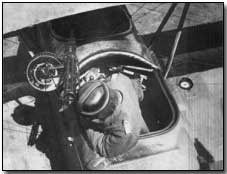The War in the Air - Fighters: Deflector and Interrupter, The Birth of the Fighter
 Roland
Garros, the French pre-war aviator, had come to the conclusion
that a fixed, forward firing
machine gun was the right
answer to the problem of using machine guns from within aircraft (see
Fighter
Aircraft - Early Days).
Roland
Garros, the French pre-war aviator, had come to the conclusion
that a fixed, forward firing
machine gun was the right
answer to the problem of using machine guns from within aircraft (see
Fighter
Aircraft - Early Days).
His first attempt at a solution was to fix a machine gun at an oblique angle in order to miss the propeller, but this was too difficult to aim.
On a visit to Paris he met up with Raymond Saulnier, of the Morane-Saulnier company, manufacturer of the tractor powered monoplane he was flying.
Before the war Saulnier had considered the problem of firing forward through the airscrew, and had experimented with an interrupter gear. The idea was that the position of the propeller would control the machine gun - preventing it from firing if the propeller was in front of the muzzle. The machine gun he used was the Hotchkiss, but its rate of fire was too erratic, and he abandoned the idea, as had a number of other pre-war experimenters.
When Garros and Saulnier talked, early in 1915, they considered another approach - to attach steel deflector plates that would deflect any bullets that hit the propeller. These were triangular in shape, with the apex pointing to the pilot - the idea being that the bullets would be deflected off at an angle, but forwards of the aircraft, rather than bouncing back at the pilot.
Garros tried out this arrangement for the first time on 1st of April, 1915 with immediate success, shooting down a two seater reconnaissance plane on his first pass. This was followed up with victories on the 13th and the 18th.
The French press immediately picked up on this success, and he was the first pilot to be labelled an "ace". At the time the term was a generic one describing someone particularly skilled in a certain area. Shortly after this the term became formalized to mean anyone who has shot down five or more aircraft, a designation which has remained to this day.
The French equipped a small number of their planes with deflector gear, and sold some deflector equipped Morane-Saulnier's to the RFC.
But Garros' luck was running out. On the 19th of April, while attacking the Courtrai railway station, a bullet fired by a rifleman on the ground pierced Garros' fuel line. He managed to put the aircraft down safely, but failed in his attempt to set it alight before he was captured. (Garros later escaped, only to be killed in action one month before the end of the war.)
The Germans passed on the captured plane to Anthony Fokker, provided him with a Parabellum machine gun, and ordered him to produce something similar.
Fokker, a Dutchman, was the manufacturer of the "Eindecker" (Monoplane) aircraft, which were being used at the time as a communications plane. Ironically, the Eindecker was an aircraft which Fokker had designed after being impressed with the Morane-Saulnier's capabilities, and its engine was a copy of the French Gnome rotary engine.
Fokker was unimpressed with the deflector gear. Whether he was aware of the work done by others on interrupter gear, whether perhaps he was already working on his own, or whether, as he claimed, he had a moment of inspiration, is not known. What is known is that within 48 hours he returned with an Eindecker equipped with interrupter gear.
Fokker first demonstrated it from the ground. The German officers were sceptical, some of them believing it was a trick. They demanded that Fokker demonstrate it from the air, which he did. Still sceptical, they demanded that Fokker actually shoot down an aircraft.
In July of 1915 Fokker himself flew a number of sorties, looking for a victim, but when he finally stumbled across an unarmed Farman observation plane he found that he could not bring himself to pull the trigger. He returned to the airfield at Douia and informed the Germans that they would have to prove the interrupter gear's potential for themselves.
The task was given to Lieutenant Oswald Boelcke. Within a few days, on the 1st of August 1915, Boelcke made his first kill. Now completely convinced, the Idflieg (Inspectorate of Flying Troops) immediately placed orders for interrupter-gear equipped Eindeckers. The Germans began to enjoy immediate success - especially Boelcke and his second in command Max Immelmann.
Just as the French press had earlier lauded Garros now Boelcke and Immelmann became darlings of the German press. Thus began the period on the Western Front known as the "Fokker Scourge".
Article contributed by Ari Unikoski
Next - Fighters - The Fokker Scourge
"Jerry" was a nickname used by the Allies to describe German soldiers.
- Did you know?
